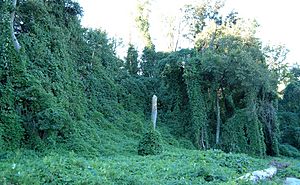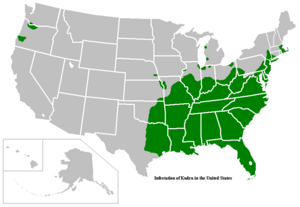Kudzu in the United States facts for kids
Kudzu is a fast-growing plant that causes big problems in the United States. It came from Asia and is known as "the vine that ate the South." This plant spreads very quickly. It grows faster than people can spray chemicals or mow it down. This costs a lot of money, about $6 million each year. Some experts say it spreads over 2,500 acres (1,000 hectares) yearly. Others think it covers as much as 150,000 acres (60,000 hectares) every year.
Contents
What is Kudzu?
Kudzu is a plant that lives for many years. It is part of the bean family. It originally comes from Asia, especially warm and mild parts of China, Japan, and Korea. Its leaves have three parts, like a clover. Each leaflet is large and oval-shaped. They have two or three smaller sections and feel hairy underneath.
How Kudzu Grows
Kudzu leaves can take nitrogen from the air. This helps the plant grow well, even in poor soil. The vines have special spots called nodes. From these nodes, new stems or tendrils can grow. These help the vine climb and attach to almost any surface.
Kudzu roots can also grow into the soil from these nodes. This helps the vine stay firmly in place. The roots are thick and full of starch and water. They can make up to 40% of the plant's total weight. This helps the roots grow very large.
Kudzu mostly spreads by making copies of itself (cloning). This happens when a stem touches the soil and roots grow. For new seeds, kudzu needs insects to carry pollen.
Kudzu likes sunny places, like forest edges. But it can also grow in full sun or partial shade. These traits made it popular for shading porches in the southeastern U.S. However, they also helped it become a "structural parasite." This means it grows over and covers entire buildings and trees if not stopped.
The name "kudzu" comes from the Japanese word "kuzu."
Where Did Kudzu Come From?
Kudzu likely started in Japan or China. In its home countries, cold winters often kill the top parts of the plant. This keeps it from spreading too much. In Japan, kudzu grows in mountains and lowlands. In Korea, it can survive very cold temperatures.
Kudzu first arrived in the United States from Japan in 1876. It was shown at a big exhibition in Philadelphia. Later, in 1883, it was introduced to the Southeast at another exhibition. People thought it was a pretty plant for shading porches.
In the early 1900s, kudzu was also promoted as food for cattle. It was also used to stop soil from washing away. Workers from the Civilian Conservation Corps planted it to help with erosion during the Dust Bowl. The government even paid farmers to plant kudzu. By 1946, about 1.2 million hectares (3 million acres) of kudzu had been planted.
When farmers left their lands, kudzu was left to grow wild. The warm, wet climate of the Southeast allowed it to spread without anything stopping it. In 1953, the U.S. Department of Agriculture removed kudzu from its list of helpful plants. By 1970, it was called a weed. In 1997, it was put on the "Federal Noxious Weed List."
Today, kudzu covers about 3 million hectares (7.4 million acres) in the southeastern U.S. It is found mostly in Alabama, Georgia, and Mississippi. It has also been seen in Canada and New York City.
How People Use Kudzu
In the U.S., kudzu has been used as food for farm animals. It has also been used in fertilizer and to stop soil erosion. People have even used its vines to make art.
In Korea, kudzu roots are used to make starch for food and herbal medicine. In China, the roots are used in teas and remedies. In Japan, kudzu root starch is used in cooking and traditional medicines. It is also fed to sick animals. Kudzu is also a food crop in some parts of Asia and South America.
Other possible uses for kudzu include paper, food, and even making honey. Some people are also looking into using it for biofuel.
How Kudzu Affects Nature
Kudzu was brought to North America on purpose in the 1930s. The idea was to help stop soil erosion in the Southeast. At first, it was just a pretty plant for homes. But soon, people started using it more widely. This helped it spread across the region.
In 135 years, kudzu has covered over 3 million hectares (7.4 million acres) in the southern U.S. It keeps spreading at about 50,000 hectares (123,500 acres) per year. It damages power lines, buildings, and native plants. The states with the most kudzu are Georgia, Alabama, and Mississippi.
Kudzu's Impact on Other Plants
Kudzu harms or kills other plants by covering them with its leaves. It can wrap around tree trunks, break branches, or even pull down whole trees. Kudzu grows very fast and can get resources quickly. This helps it win against native plants.
Many plants that can compete with kudzu are also invasive species. These include Chinese privet and Japanese honeysuckle. Kudzu is a big problem in the Southeast because this area has many different kinds of plants and animals. Kudzu reduces this variety, turning areas into "vine barrens."
Kudzu is very tough. It can handle dry weather. Only the parts above ground are hurt by frost. Kudzu also works with special bacteria to take nitrogen from the air. This nitrogen helps it grow in poor soils where other plants cannot. Kudzu adds a lot more nitrogen to the soil than native plants do. This helps it grow huge leaves and make a lot of food through photosynthesis.
Kudzu grows very fast, about 0.3 meters (1 foot) every day. The vine can reach up to 30 meters (98 feet) long. It puts a lot of its energy into growing roots. These roots can weigh over 180 kg (400 lb) and grow 18 cm (7 inches) wide. They can also grow 3 cm (1.2 inches) deeper into the soil each day.
Kudzu can root wherever its stems touch the ground. This allows it to spread in all directions. Once rooted, most stems become separate plants. This means you have to remove every single stem to get rid of it.
Kudzu leaves move to follow the sun. This helps them get the most sunlight for making food. Kudzu is also a "structural parasite." It grows on top of other plants and buildings to reach the light. By quickly covering shrubs, trees, and forests, it blocks sunlight from the plants below. This stops them from making food and can kill them.
Kudzu's Economic Impact
Kudzu costs the United States a lot of money. It causes about $100 million to $500 million in lost forest growth each year. It also costs about $5,000 per hectare ($2,000 per acre) each year to control it. Power companies spend about $1.5 million yearly to fix damaged power lines.
Kudzu is also a problem for national parks in the Southeast. For example, at Vicksburg National Military Park, kudzu has taken over 190 acres (77 hectares). It threatens the historical value of the park.
How We Control Kudzu
Controlling kudzu is hard because it spreads in many ways. It grows from runners, underground stems, nodes on vines, and seeds. Even small root pieces left by mowers can grow into new plants.
Cutting and Mowing
One way to control kudzu is by mowing or cutting it. These methods take a lot of time. You need to mow the vines close to the ground every month or two during the growing season. All cut plant material must be removed or destroyed. This stops the vines from rooting and growing back. Another method is to remove the plant's crown (the part where the roots and stems meet). This part also needs to be destroyed.
Using Chemicals
Using chemicals called herbicides is another option. Some common ones are picloram and triclopyr. The most effective ones are picloram and tebuthiuron. However, these treatments are expensive. Killing the plant completely needs a lot of herbicide. Herbicides work best when used during the growing season (June–October) for several years. Some studies show a big drop in kudzu growth after two years. Others needed up to ten years of treatment.
Another chemical method is soil solarization. This uses heat from the sun to kill the plant's root system. It avoids using pesticides. Soil solarization also changes the nutrients in the soil. It increases potassium, which is good for soils in the Southeast.
Natural Helpers
Since chemicals and cutting are often hard and costly for long-term control, scientists are looking for natural ways to fight kudzu. Some natural controls already exist. These include plant diseases, insects that eat the plant, and insects that eat its seeds.
Many seeds are damaged by insects. One study found 25 different insect species eating kudzu. Some beetles and sawflies only eat kudzu. Other studies found weevils that attack stems and beetles that grow in the roots.
Scientists must be careful when finding natural controls. Organisms that eat kudzu might also eat other important plants, like soybeans. So, potential controls are tested to make sure they don't harm other plants.
A fungus called Myrothecium verrucaria looks promising as a natural control. It works well in warm conditions. Also, it does not spread outside the areas where it is used. However, this fungus is toxic to mammals, so it must be handled with extreme care.
Animals That Help
One early way to control kudzu was letting cattle and other farm animals eat it. Kudzu is good food for many animals. But the grazing area must be fenced. Animals also need to move to different areas as they eat the kudzu. Only by repeated grazing will the plant's root reserves get used up.
Today, goats and pigs are considered the best animals for controlling kudzu. In Tennessee, a company uses about 200 goats to clear one acre of kudzu per day.
See also
- Environmental issues in the United States
- Invasive species in the United States





